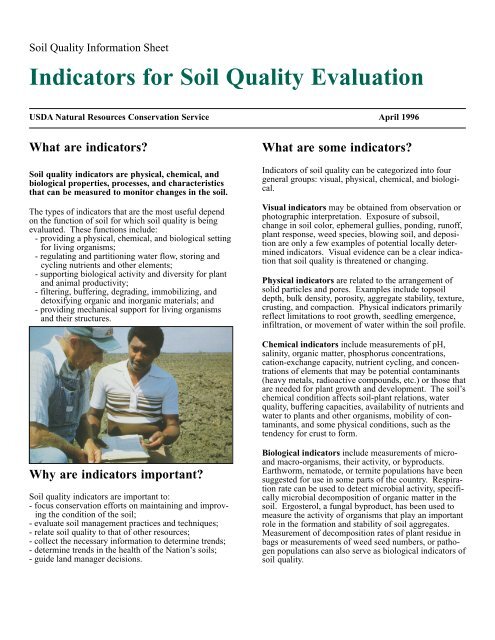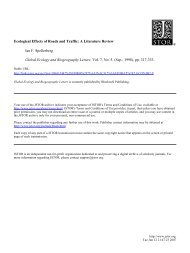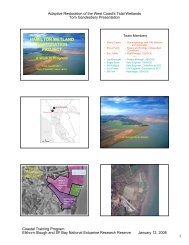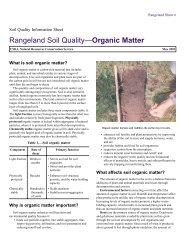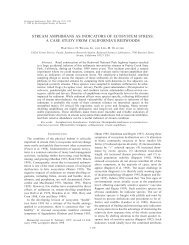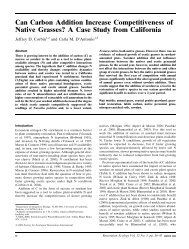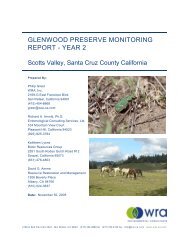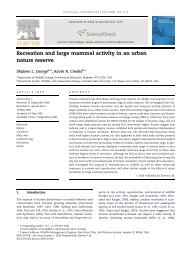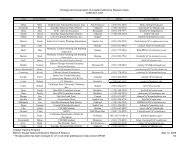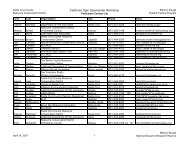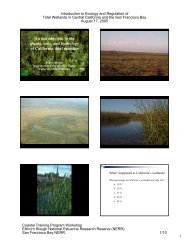Indicators for Soil Quality Evaluation - NRCS Soils - US Department ...
Indicators for Soil Quality Evaluation - NRCS Soils - US Department ...
Indicators for Soil Quality Evaluation - NRCS Soils - US Department ...
Create successful ePaper yourself
Turn your PDF publications into a flip-book with our unique Google optimized e-Paper software.
<strong>Soil</strong> <strong>Quality</strong> In<strong>for</strong>mation Sheet<br />
<strong>Indicators</strong> <strong>for</strong> <strong>Soil</strong> <strong>Quality</strong> <strong>Evaluation</strong><br />
<strong>US</strong>DA Natural Resources Conservation Service April 1996<br />
What are indicators?<br />
<strong>Soil</strong> quality indicators are physical, chemical, and<br />
biological properties, processes, and characteristics<br />
that can be measured to monitor changes in the soil.<br />
The types of indicators that are the most useful depend<br />
on the function of soil <strong>for</strong> which soil quality is being<br />
evaluated. These functions include:<br />
- providing a physical, chemical, and biological setting<br />
<strong>for</strong> living organisms;<br />
- regulating and partitioning water flow, storing and<br />
cycling nutrients and other elements;<br />
- supporting biological activity and diversity <strong>for</strong> plant<br />
and animal productivity;<br />
- filtering, buffering, degrading, immobilizing, and<br />
detoxifying organic and inorganic materials; and<br />
- providing mechanical support <strong>for</strong> living organisms<br />
and their structures.<br />
What are some indicators?<br />
<strong>Indicators</strong> of soil quality can be categorized into four<br />
general groups: visual, physical, chemical, and biological.<br />
Visual indicators may be obtained from observation or<br />
photographic interpretation. Exposure of subsoil,<br />
change in soil color, ephemeral gullies, ponding, runoff,<br />
plant response, weed species, blowing soil, and deposition<br />
are only a few examples of potential locally determined<br />
indicators. Visual evidence can be a clear indication<br />
that soil quality is threatened or changing.<br />
Physical indicators are related to the arrangement of<br />
solid particles and pores. Examples include topsoil<br />
depth, bulk density, porosity, aggregate stability, texture,<br />
crusting, and compaction. Physical indicators primarily<br />
reflect limitations to root growth, seedling emergence,<br />
infiltration, or movement of water within the soil profile.<br />
Chemical indicators include measurements of pH,<br />
salinity, organic matter, phosphorus concentrations,<br />
cation-exchange capacity, nutrient cycling, and concentrations<br />
of elements that may be potential contaminants<br />
(heavy metals, radioactive compounds, etc.) or those that<br />
are needed <strong>for</strong> plant growth and development. The soil’s<br />
chemical condition affects soil-plant relations, water<br />
quality, buffering capacities, availability of nutrients and<br />
water to plants and other organisms, mobility of contaminants,<br />
and some physical conditions, such as the<br />
tendency <strong>for</strong> crust to <strong>for</strong>m.<br />
Why are indicators important?<br />
<strong>Soil</strong> quality indicators are important to:<br />
- focus conservation ef<strong>for</strong>ts on maintaining and improving<br />
the condition of the soil;<br />
- evaluate soil management practices and techniques;<br />
- relate soil quality to that of other resources;<br />
- collect the necessary in<strong>for</strong>mation to determine trends;<br />
- determine trends in the health of the Nation’s soils;<br />
- guide land manager decisions.<br />
Biological indicators include measurements of microand<br />
macro-organisms, their activity, or byproducts.<br />
Earthworm, nematode, or termite populations have been<br />
suggested <strong>for</strong> use in some parts of the country. Respiration<br />
rate can be used to detect microbial activity, specifically<br />
microbial decomposition of organic matter in the<br />
soil. Ergosterol, a fungal byproduct, has been used to<br />
measure the activity of organisms that play an important<br />
role in the <strong>for</strong>mation and stability of soil aggregates.<br />
Measurement of decomposition rates of plant residue in<br />
bags or measurements of weed seed numbers, or pathogen<br />
populations can also serve as biological indicators of<br />
soil quality.
How are indicators selected?<br />
<strong>Soil</strong> quality is estimated by observing or measuring<br />
several different properties or processes. No single<br />
property can be used as an index of soil quality.<br />
The selection of indicators should be based on:<br />
- the land use;<br />
- the relationship between an indicator and the soil<br />
function being assessed;<br />
- the ease and reliability of the measurement;<br />
- variation between sampling times and variation<br />
across the sampling area;<br />
- the sensitivity of the measurement to changes in soil<br />
management;<br />
- compatibility with routine sampling and monitoring;<br />
- the skills required <strong>for</strong> use and interpretation.<br />
When and where to measure?<br />
The optimum time and location <strong>for</strong> observing or sampling<br />
soil quality indicators depends on the function <strong>for</strong><br />
which the assessment is being made. The frequency of<br />
measurement also varies according to climate and land<br />
use.<br />
<strong>Soil</strong> variation across a field, pasture, <strong>for</strong>est, or rangeland<br />
can greatly affect the choice of indicators. Depending<br />
on the function, such factors as the landscape unit, soil<br />
map unit, or crop growth stage may be critical. Wheel<br />
tracks can dramatically affect many properties measured<br />
<strong>for</strong> plant productivity. Management history and current<br />
inputs should also be recorded to ensure a valid interpretation<br />
of the in<strong>for</strong>mation.<br />
Monitoring soil quality should be directed primarily<br />
toward the detection of trend changes that are measurable<br />
over a 1- to 10-year period. The detected changes<br />
must be real, but at the same time they must change<br />
rapidly enough so that land managers can correct<br />
problems be<strong>for</strong>e undesired and perhaps irreversible loss<br />
of soil quality occurs.<br />
Strongly Acid<br />
Medium<br />
Acid<br />
Slightly<br />
Acid<br />
IRON<br />
MANGANESE<br />
BORON<br />
COPPER AND ZINC<br />
Very<br />
Slightly<br />
Acid<br />
Very<br />
Slightly<br />
Alkaline<br />
NITROGEN<br />
PHOSPHOR<strong>US</strong><br />
POTASSIUM<br />
SULPHUR<br />
CALCIUM<br />
MAGNESIUM<br />
Slightly<br />
Alkaline<br />
Medium<br />
Alkaline<br />
MOLYBDENUM<br />
FUNGI<br />
BACTERIA AND ACTINOMYCETES<br />
<strong>Soil</strong> reaction influence on availability of plant nutrients.<br />
What does the value mean?<br />
Strongly Alkaline<br />
4.0 4.5 5.0 5.5 6.0 6.5 7.0 7.5 8.0 8.5 9.0 9.5 10.0<br />
Interpreting indicator measurements to separate soil<br />
quality trends from periodic or random changes is<br />
currently providing a major challenge <strong>for</strong> researchers<br />
and soil managers. <strong>Soil</strong>s and their indicator values vary<br />
because of differences in parent material, climatic<br />
condition, topographic or landscape position, soil<br />
organisms, and type of vegetation. For example,<br />
cationexchange capacity may relate to organic matter,<br />
but it may also relate to the kind and amount of clay.<br />
Establishing acceptable ranges, examining trends and<br />
rates of change over time, and including estimates of the<br />
variance associated with the measurements are important<br />
in interpreting indicators. Changes need to be evaluated<br />
as a group, with a change in any one indicator being<br />
evaluated only in relation to changes in others. <strong>Evaluation</strong>s<br />
be<strong>for</strong>e and after, or with and without intervention,<br />
are also needed to develop appropriate and meaningful<br />
relationships <strong>for</strong> various kinds of soils and the functions<br />
that are expected of them.<br />
The overall goal should be to maintain or improve soil<br />
quality without adversely affecting other resources.<br />
(Prepared by the National <strong>Soil</strong> Survey Center in cooperation with the <strong>Soil</strong> <strong>Quality</strong> Institute, <strong>NRCS</strong>, <strong>US</strong>DA, and the National <strong>Soil</strong><br />
Tilth Laboratory, Agricultural Research Service, <strong>US</strong>DA)<br />
________________________________________________________________________________________________________________________<br />
The United States <strong>Department</strong> of Agriculture (<strong>US</strong>DA) prohibits discrimination in its programs on the basis of race, color, national origin, sex, religion, age,<br />
disability, political beliefs, and marital or familial status. (Not all prohibited bases apply to all programs.) Persons with disabilities who require alternative means <strong>for</strong><br />
communication of program in<strong>for</strong>mation (braille, large print, audiotape, etc.) should contact the <strong>US</strong>DA Office of Communications at (202) 720-2791.<br />
To file a complaint, write the Secretary of Agriculture, U.S. <strong>Department</strong> of Agriculture, Washington, D.C., 20250, or call (202) 720-7327 (voice) or<br />
(202) 720-1127 (TDD). <strong>US</strong>DA is an equal employment opportunity employer.


